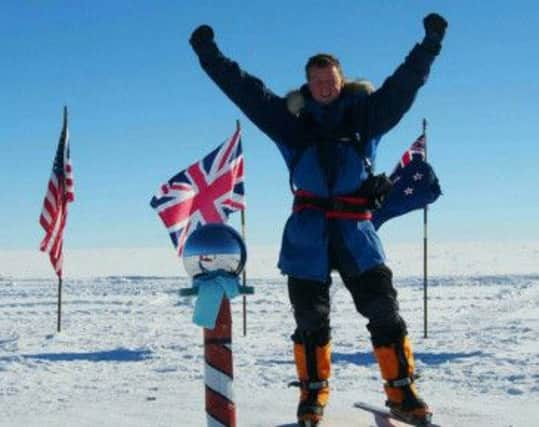Scot is first Briton to ski solo to the South Pole


Newall Hunter, from Leadhills in South Lanarkshire, battled fierce conditions for 41 days to cross from the Ronne Ice Shelf to the polar ice cap.
After a 570-mile trip which at one point saw the snow collapse beneath his skis to reveal a gaping crevasse, Mr Hunter arrived at the Pole on Sunday, 4 January.
Advertisement
Hide AdAdvertisement
Hide AdHe reached the famed spot having spent his birthday on Christmas Eve pulling two equipment-laden sleds in visibility so bad that he could not see beyond the end of his skis.
The route he followed was last taken by mountaineer Messner and his fellow explorer Arved Fuchs.
Upon reaching the Union Glacier South Pole base, Mr Hunter said: “I have made it to the South Pole. I arrived about 3:30am (Union Glacier local time) so everyone from Union Glacier was asleep. Which meant I had the Pole all to myself.”
Now that he has reached his goal he will spend a number of days recuperating before attempting his next challenge of climbing Mount Vinson, the highest mountain on the polar continent.
His daily log on his website reveals how he narrowly avoided catastrophe: “A bit of excitement today – that I could do without. Was skiing along thinking it was time to stop for some food, when the snow below my right ski felt a bit soft.
“I looked down – the snow had gone and a crevasse had opened up right under my feet. My ski tips were on one side of it and my ski tails on the other and nothing under my feet. I knew I was in a crevasse area and was being careful and looking out for any.
CONNECT WITH THE SCOTSMAN
• Subscribe to our daily newsletter (requires registration) and get the latest news, sport and business headlines delivered to your inbox every morning
“There was absolutely no indication on the surface that it was there. Normally you see holes or the snow sags but there was nothing. The snow covering it was new and only about four inches thick.”
Advertisement
Hide AdAdvertisement
Hide AdBefore leaving the UK, Mr Hunter explained why he was taking on the challenge: “I am working on the Explorers’ Grand Slam of climbing the seven summits (the highest mountains on each of the continents) and skiing to the geographic North and South Poles. Conquering Mount Vinson will leave me just two more to climb.”
Mr Hunter began climbing in his early teens and by his early twenties had completed many of the classic winter routes solo, including ascents of the Matterhorn, Monte Rosa and multiple ascents of Mont Blanc.
He has successfully climbed Aconcagua in South America, Kilimanjaro in Africa and Denali in Alaska, and in 2011 he scaled Everest. He still has to climb Mount Elbrus in Russia and the Carstensz Pyramid in Indonesia.
This year also sees the centenary of Ernest Shackleton’s failed attempt to cross Antarctica, which resulted in one of the most heroic rescue missions in history, and Mr Hunter will join a British and Irish team attempting to be the first to complete Shackleton’s thwarted crossing.
On 27 October, exactly 100 years to the day, the team will pick up where he left off and attempt to complete his crossing of Antarctica from the Weddell Sea to the Ross Sea via the South Pole.
Mr Hunter added: “What our team wants to do for the Shackleton centenary is ski and kite-ski the complete coast-to-coast route that Shackleton had planned to be the first crossing of the Antarctic continent. We believe that this route has still not been completed.”
The expedition will see sledges pulled 1,800 miles over 92 days in temperatures of -50°C and winds of 100mph. The team will use kites to help pull the sledges across the ice to save time in the very short season when conditions are expected to be best.
SCOTSMAN TABLET AND IPHONE APPS